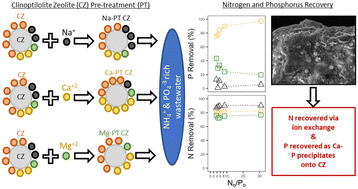Evaluating the use of chemically modified clinoptilolite zeolite for the simultaneous recovery of ammonium and phosphate from blackwater†
Abstract
Natural clinoptilolite zeolite (CZ) was chemically modified with sodium (Na), calcium (Ca), or magnesium (Mg) to recover ammonium and phosphate from simulated blackwater. Chemical modification of CZ with Na, Ca, and Mg was able to increase the mass of each metal by a factor of 2.2, 2.7, and 1.8, respectively. The removal performance of ammonium and phosphate by each chemically modified CZ under concentrations relevant to onsite wastewater treatment systems was evaluated. Initially, single ion isotherm tests were conducted to quantify phosphate and ammonium removal without the presence of the opposite nutrient. Without ammonium present, phosphate removal with Na and Mg modified CZ was marginal, observing sorption capacities of 0.06 ± 0.19 and 0.17 ± 0.12 g P g−1, respectively, at a starting concentration of 95 mg P L−1. At the same starting concentration, Ca modified CZ observed the highest phosphate sorption of 0.45 ± 0.08 g P g−1. Phosphate removal was enhanced by the presence of ammonium in solution for Na, Mg and Ca modified CZ, achieving sorption capacities up to 0.38 ± 0.06, 0.98 ± 0.02 and 2.92 ± 0.01 mg P g−1, respectively, at a starting phosphate concentration of 120 mg P L−1. These removal capacities were associated with phosphate removal rates of 9.5 ± 1.4%, 24.4 ± 0.6% and 72.7 ± 0.4% for Na, Mg and Ca modified CZ. The removal of ammonium remained consistent across a range of phosphate concentrations. The Langmuir isotherm model best predicted the phosphate sorption behavior to Mg and Ca modified CZ when ammonium was not present. When both nutrients were present in solution together, the Freundlich isotherm model best depicted the phosphate sorption behavior to Mg and Ca modified CZ. This change in isotherm behavior was due to a shift in surface reactions from primarily adsorption to primarily complexation. In both cases, phosphorus was recovered onto the zeolite surface as calcium phosphate precipitates. This supports the idea that the Ca content of the CZ, regardless of which metal was used for chemical modification, dictated the phosphate removal performance. X-ray fluorescence revealed that the zeolite granules retained nitrogen, phosphorus, and potassium at a molar ratio of 5.3 : 1 : 13.4 which can be used as a complete fertilizer or as an amendment for incomplete fertilizers.

- This article is part of the themed collection: Recent Open Access Articles


 Please wait while we load your content...
Please wait while we load your content...